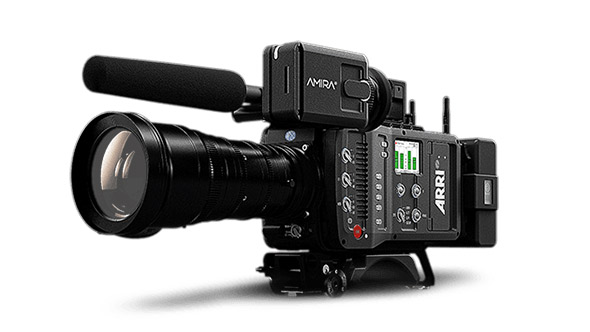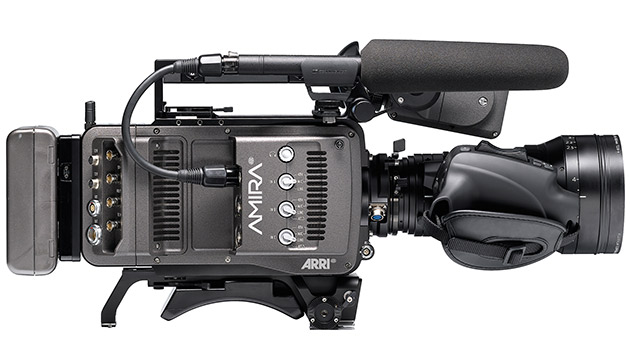ARRI gave Alexa a sister today with the announcement of Amira, a new "documentary-style" shoulder-mounted camera built around the same sensor as the Alexa and designed for single-operator use. The camera shoots in 1080p HD and 2K at up to 200 fps, claims the same 14-stop dynamic range as the Alexa, and includes pre-loaded looks based on 3D LUTs for in-camera color grading.
The Amira records Rec. 709 or Log C images in camera to SanDisk's new CFast 2.0 flash memory cards (read on for more on those) using ProRes 422, 422 (LT), 422 (HQ), or 4444 codecs — but not ARRIRAW. That's an indicator that the Amira is built for utility and speed in both production and post — ARRI said it will boot quickly with no set-up tasks or other delays to slow it down in run-and-gun environments and stressed that the Amira has a rugged construction that will be an asset under punishing field conditions.

And ARRI seems to be making sure shooters have options for managing their color in camera, rather than relying on fiddling in post. In addition to the pre-loaded looks, DPs can load custom LUTs into the camera before the shoot, and 3D LUTs can even be modified during the shoot.
Also on board are motorized ND filters, zebra and false-color displays, and an advanced peaking function for aiding quick focusing. Both a flip-out LCD monitor and an OLED eyepiece are included.
Unfortunately, there was no word this morning on the two most important questions: when will it ship, and how much will it cost? But ARRI has indicated that it will be priced well below the Alexa. Stay tuned.
By the way, ARRI was a collaborator with SanDisk in the development of that new CFast 2.0 standard, which is being supported on the Alexa, as well, through a just-announced recording adapter for Alexa XT and XR cameras.
The cards, which have a pinless design to reduce the chances of damage on insertion or removal, will ship in 60 GB and 120 GB capacities, and support writing at up to 350 MB/sec — enough to record ProRes 4444 at up to 120 fps. ARRI said CFast 2.0 card recordings, like those on SxS Pro cards, are closed continuously, so if the card is accidentally ejected or power is lost during a recording, the file on the card is not corrupted.
ARRI's latest Alexa software update (v9.0) enables the higher-speed ProRes recording as well as a ProRes Pre-Recording option that keeps the camera recording in a continuously buffering mode so that nature cinematographers don't miss their shot. Also new is DNxHD 444 support for all DNxHD-licensed cameras, a "self-healing metadata" feature to repair a prematurely closed file an allow the media to be reused, and support for Cooke /i lens data in Alexa Classic cameras with a PL-LDS mount.
Crafts: Shooting
Sections: Technology
Topics: New product Alexa amira ARRI cfast 2.0 ibc 2013 ProRes
Did you enjoy this article? Sign up to receive the StudioDaily Fix eletter containing the latest stories, including news, videos, interviews, reviews and more.










Looks amazing. What kinda of price point are we looking at?
Below the Alexia… and that’s still not a comforting hint. HA!
This will be a very good hire camera. If the colour rendition is the same as the Alexa I have no problem with 2K, even for cinema. It’s not the pixel resolution that is so important but the way the the sensor resolves those pixels to a codec that makes or breaks.
Without pricing, I’m sitting here trying to care. Arri makes amazing stuff, but it’s usually so far out of the price range of everything else you might as well buy a Red.
Continue to sit there and try Sam….. better off that way for yourself and the rest – passionate storytelling professionals who embrace new technology with inspiration and cinematic zest honoring the hard work of dedicated engineers + manufacturers bringing these amaaaazing new tools to our creative hands…. we collectively aspire to share silky visual stories one shoot at a time….. positively.
Has there ever been a better time to be behind the camera?
US$20K-24K optimum result – lets wait and see. Happy shooting with that not-so-comfy #Red
Best
Marcus
If it’s in the 20k ballpark, I’m in but I highly doubt it. I’m betting it’s in the high 40s to 50.
With the Canon C300 being everyone’s favorite documentary style camera, and Sony’s F5, I’m thinking this thing will be in the $15K-$20K ballpark just to compete. It’s no Alexa!
While a great camera undoubtedly, it is not 4k. Which does not make it a very future proof investment in my world. I know, there is more than resolution, but by now it is a factor to keep in mind. Once HD took off, SD cameras were out of business quickly. Same tipping point is getting closer on the acquisition side of footage. The camera has a lot going for it, but I am putting my money elsewhere.
Well, as all said it might be a bit pricey. It seems like it aims to rival Sony F55 rather than F5, but as it was already noticed – this is not a 4K camera.
So my guess is that 99% indie filmmakers will say no to this cam.
Prime buyers probably would be TV Networks (and Cables) who would buy it for their ‘in-house’ production. I guess to them that would be a good deal, as this camera wouldn’t require neither a lot of maintenance or additional crew, hence it will help them to cut down some wages (less people involved with the process) and to lower overhead. So, this cam yet may theoretically affect indie market as well, as it will help them (NatGeo, Discovery, etc.) to cut down doc budgets, therefore it might effect negotiating pick up deals.
This will be a direct competitor with the new Varicams. Expect 50-60K price range IMO. Varicam 3 offers 444 straight to P2, and the forthcoming Varicam 4K will have that and a S35 sensor to boot. Amira will be slugging it out with those two for sure.
Great camera very cool form factor, great way to squeeze a little longevity out of a absolutely wonderful sensor, but… No 4K. On Arri’s mini site for Amira is says “safe long term investment’ maybe a 4K paid upgrade in the future? Who knows…
People really need to stop banging on about 4K….colour science and the dynamic range of camera’s are far more important. People need to remember that 90% of people still watch the majority of TV in SD, let alone even HD. It is also worth noting that just because it doesn’t capture in 4K does not mean it can’t upres to 4K output if needed.
This has been designated as a TV doc style camera and for that it will excel, slightly depending on the price point. IF you feel that 4K is needed and you are shooting very high end commercials or feature film then rent the Alexa, for TV, Doc and corporate this camera is exceptional, Alexa image, with little to no post workflow necessary upto 200fps onto small media is a dream.
Phil
I see your point. But with technology going so fast and 4K popping up more and more, I don’t feel like having the same situation with the switch from SD to HD: my archive of footage became more or less useless for many purposes. We’ve been acquiring footage in 4K since 2008 and I am very happy I did! Have we been delivering in 4K since 2008? No. First things rolling out just now. But a camera is an acquisition format. Acquisition that can only be done once and costs a lot of time and money. So for the sake of futureproofing, I don’t feel like making a step towards the past/now. What a shame it would be if such a great camera as the Amira would have to sit in a corner in a few years only due to lack of resolution. It does not make sense to me from a user point of view. It does make sense to me from Arri’s point of view as they can sell again in a few years.
No I agree, shooting in 4k has its benefits in terms of future proofing but then again I don’t think this will be sitting n the corner in a few months time. The bits of 4K tha are you delivering now, in the 5 years that you have been shooting that way, I imagine that isn’t broadcast TV deliverables….many of them won’t even accept higher end codecs because of extra storage required. We have only just got to a stage where HD is being ‘expected’ in TV, and the majority still watch in SD. 4k is th imminent future for film an cinema I totally agree, but not for tv and corporate which is ultimately the market the Amira is aimed at!! I also think its worth noting that I read somewhere that you need a tv screen size of at leat 80″ to really notice a discernible difference between HD and 4K, fine for the cinema but not particularly relevant for the home.
I think where Arri are going right is making cameras for specific jobs. If you want to shoot a high end commercial or feature film then superb, use the Alexa, if you are shooting news or some types of docu then use the Amira, I would hate th idea of filming a docu on say a Dragon Epic, the storage costs would be INSANE!! It’s not always about specs but also job specific workflows….
Sorry, that turned into a bit of an essay 😉
Phil
Thanks for your essay Phil 😉 Seriously though, you have valid points, especially when it comes to delivering for broadcast. However the broadcast landscape is also slowly changing, with more and more things happening online. Or on tablets with ever increasing pixel counts. If I look at some of the HD stuff we deliver on a 27inch IMac, I already notice I shouldn’t sit to close or I’ll see the resolution of the footage can’t really keep up with the screen. Now there will be a time soon where my clients phone will shoot 4k, and he’ll look that back on his 27inch screen. This is the moment where his standards are raised and the moment I would not feel comfortable anymore showing him HD on the very same screen. And yes, if all is well he shouldn’t even notice resolution because of colors, content etc. He may never notice, he may never ask. But still… That feeling…I just want to deliver best within my possibilities. In the total mix of ingredients, resolution is only a small part, however I want it to be there. I can always scale back, up is a different story.